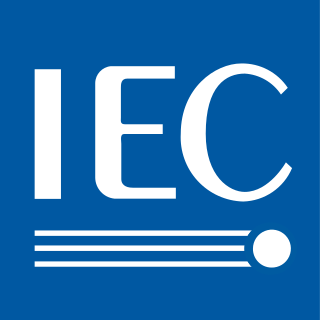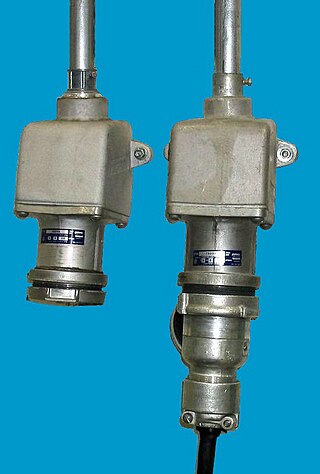Related Research Articles

The International Organization for Standardization is an independent, non-governmental, international standard development organization composed of representatives from the national standards organizations of member countries. Membership requirements are given in Article 3 of the ISO Statutes.

The International Electrotechnical Commission is an international standards organization that prepares and publishes international standards for all electrical, electronic and related technologies – collectively known as "electrotechnology". IEC standards cover a vast range of technologies from power generation, transmission and distribution to home appliances and office equipment, semiconductors, fibre optics, batteries, solar energy, nanotechnology and marine energy as well as many others. The IEC also manages four global conformity assessment systems that certify whether equipment, system or components conform to its international standards.

Electromagnetic compatibility (EMC) is the ability of electrical equipment and systems to function acceptably in their electromagnetic environment, by limiting the unintentional generation, propagation and reception of electromagnetic energy which may cause unwanted effects such as electromagnetic interference (EMI) or even physical damage to operational equipment. The goal of EMC is the correct operation of different equipment in a common electromagnetic environment. It is also the name given to the associated branch of electrical engineering.

In arithmetic, a quotient is a quantity produced by the division of two numbers. The quotient has widespread use throughout mathematics. It has two definitions: either the integer part of a division or a fraction or ratio. For example, when dividing 20 by 3, the quotient is 6 in the first sense and in the second sense.
IEC 60027 is a technical international standard for letter symbols published by the International Electrotechnical Commission (IEC), comprising the following parts:
In physics, the weber is the unit of magnetic flux in the International System of Units (SI). The unit is derived from the relationship 1 Wb = 1 V⋅s (volt-second). A magnetic flux density of 1 Wb/m2 is one tesla.

Industrial and multiphase plugs and sockets provide a connection to the electrical mains rated at higher voltages and currents than household plugs and sockets. They are generally used in polyphase systems, with high currents, or when protection from environmental hazards is required. Industrial outlets may have weatherproof covers, waterproofing sleeves, or may be interlocked with a switch to prevent accidental disconnection of an energized plug. Some types of connectors are approved for hazardous areas such as coal mines or petrochemical plants, where flammable gas may be present.

In electric power distribution, a busbar is a metallic strip or bar, typically housed inside switchgear, panel boards, and busway enclosures for local high current power distribution. They are also used to connect high voltage equipment at electrical switchyards, and low voltage equipment in battery banks. They are generally uninsulated, and have sufficient stiffness to be supported in air by insulated pillars. These features allow sufficient cooling of the conductors, and the ability to tap in at various points without creating a new joint.
Ampacity is a portmanteau for ampere capacity, defined by United States National Electrical Codes. Ampacity is defined as the maximum current, in amperes, that a conductor can carry continuously under the conditions of use without exceeding its temperature rating.

José Antonio de Artigas Sanz was a Spanish engineer who contributed to the standardization of terminology in the field of electrical engineering.

Japanese Industrial Standards (JIS) are the standards used for industrial activities in Japan, coordinated by the Japanese Industrial Standards Committee (JISC) and published by the Japanese Standards Association (JSA). The JISC is composed of many nationwide committees and plays a vital role in standardizing activities across Japan.
ISO/TC 37 is a technical committee within the International Organization for Standardization (ISO) that prepares standards and other documents concerning methodology and principles for terminology and language resources.
PackML is an industry technical standard for the control of packaging machines, as an aspect of industrial automation.
The ISO/TS 80004 series of standards, from the International Organization for Standardization, describe vocabulary for nanotechnology and its applications. These were largely motivated by health, safety and environment concerns, many of them originally elaborated by Eric Drexler in his 1985 Engines of Creation and echoed in more recent research. The ISO standards simply describe vocabulary or terminology by which a number of critical discussions between members of various stakeholder communities, including the public and political leaders, can begin. Drexler, in Chapter 15 of his 1985 work, explained how such consultation and the evolution of new social media and mechanisms to make objective scientific determinations regardless of political and industrial and public pressures, would be important to the evolution of the field. Nonetheless, it took a quarter-century for the ISO to agree and eventually standardize on this terminology.
IEC 60204-1 / EN 60204 Safety of machinery – Electrical equipment of machines – Part 1: General requirements

IEC Common Data Dictionary (abbreviated: IEC CDD) is a metadata registry providing product classification and formalized product descriptions that can be used in the context of smart manufacturing and Industrie 4.0.
IEC 61360, with the title "Standard data element types with associated classification scheme", is a series of standard documents defining a general purpose vocabulary in terms of a reference dictionary published by the International Electrotechnical Commission.
References
- ↑ "ISO/IEC Directives – Supplement, Procedures specific to IEC" (PDF). ISO/IEC DIR. IEC. 2021-05-20. Retrieved 2020-10-24.
- ↑ Raeburn, Anthony. "The first 50 years". Who we are / About us / History. IEC. Retrieved 2021-10-24.
AC 1 (Nomenclature), founded in 1910 was chaired by a Belgian professor, which indicates that in the early years of the 20th century electrical engineers used almost equally English, French and German.
- 1 2 "First technical committees". IEC. Retrieved 2021-10-22.
By 1914, the IEC had formed four technical committees to deal with nomenclature, symbols, rating of electrical machinery, and prime movers. The Commission had also issued a first list of terms and definitions covering electrical machinery and apparatus; a list of international letter symbols for quantities and signs for names of units; an international standard for resistance for copper; a list of definitions in connection with hydraulic turbines; and a number of definitions and recommendations relating to rotating machines and transformers.
- ↑ Sample page in the review "Esperanto" Oct. 1935, p. 135.
- ↑ "IEC TC/SCs - List of IEC Technical Committees and Subcommittees". Iec.ch. Retrieved 2015-05-20.
- ↑ Kernan, Aedan. "Electropedia: A Shared Understanding". Leonardo ENERGY. Archived from the original on 2014-08-19. Retrieved 2015-05-20.
- ↑ "The Electropedia, by the International Electrotechnical Commission | The Jensen Localization Blog". Blog.jensen-localization.com. 2012-08-16. Retrieved 2015-05-20.
- ↑ "IEC 60050 - International Electrotechnical Vocabulary - Welcome". Electropedia.org. Archived from the original on 2015-04-27. Retrieved 2015-05-20.
- ↑ "ISO/IEC Directives: Procedures specific to IEC, Edition 9.0, IEC: Geneva, Switzerland, 2015-06, Supplement Figure SL.1 – Overview of the procedures, p. 58" (PDF). Archived from the original (PDF) on 2015-09-05. Retrieved 2015-12-02.
- ↑ "IEC - TC 1 Dashboard > Scope". Iec.ch. 2015-01-12. Retrieved 2015-05-20.